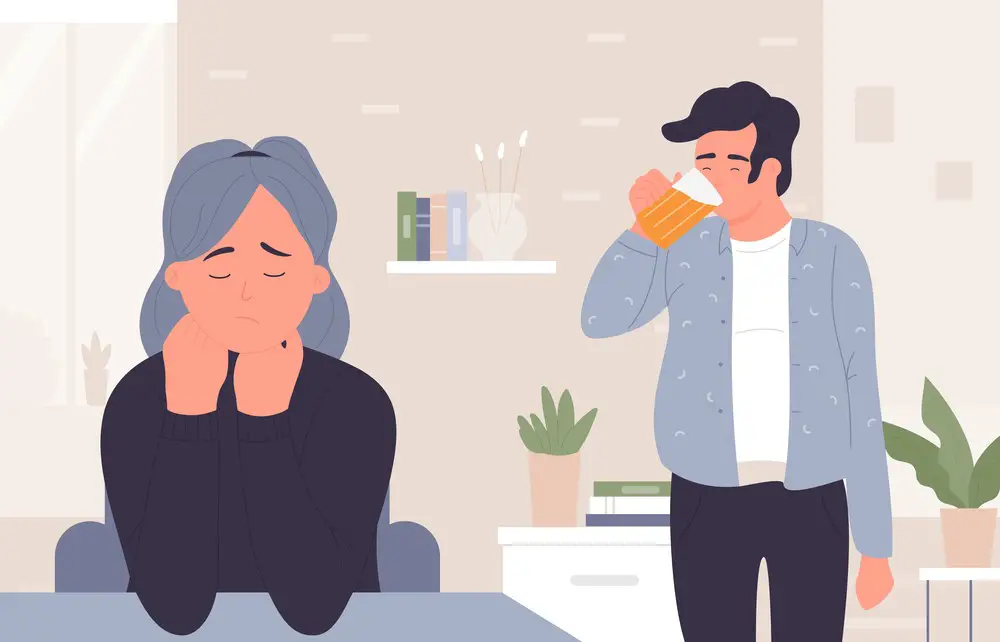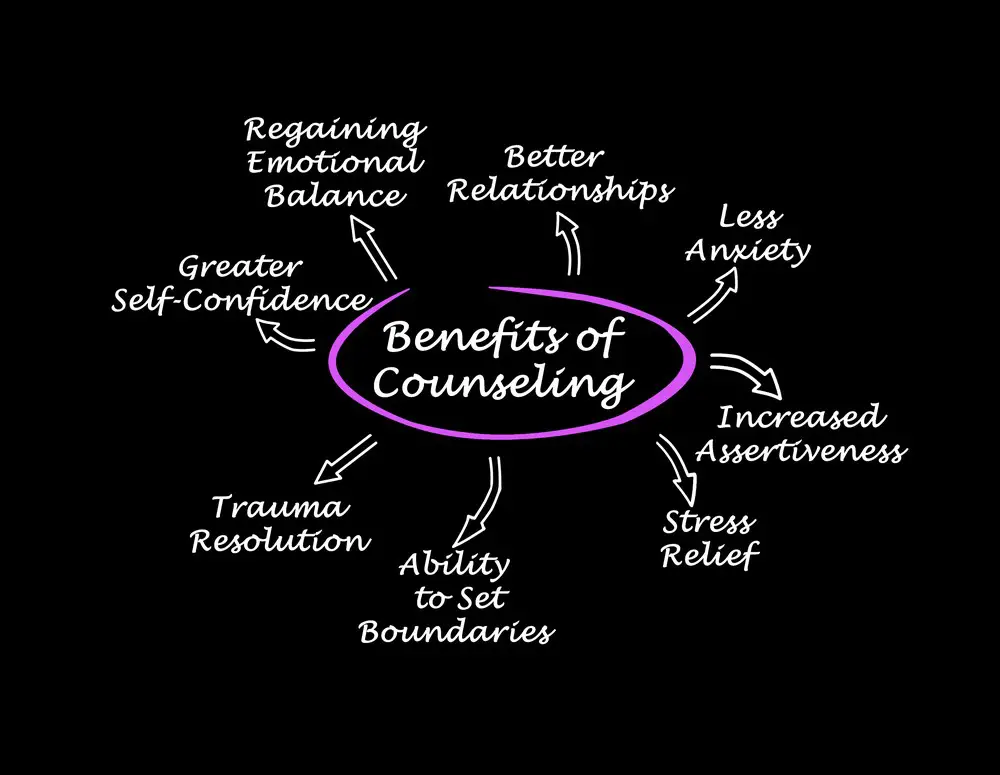As a BetterHelp affiliate, we receive compensation from BetterHelp if you purchase products or services through the links provided
Trauma bonding is an unhealthy attachment to someone who causes you physical, emotional, and sexual harm. These bonds often form subtly and slowly, making it difficult for the abused person to recognize their presence. In extreme situations, trauma bonds occur in abusive relationships, hostage situations, and incestuous relationships. Still, they can also be found in any ongoing, attached relationship in which there is significant emotional or physical control.
As the individual attempts to break free from a trauma bond, they may experience withdrawal symptoms. These can include depression, anxiety, guilt, confusion, and longing for the abuser. Recognizing and understanding these symptoms is crucial for reclaiming your life after a traumatizing relationship and moving towards a healthier and more fulfilling life.
Key Takeaways
- Trauma bonds are unhealthy attachments that develop in relationships with significant emotional or physical control.
- Breaking free from a trauma bond can result in withdrawal symptoms such as depression, anxiety, and guilt.
- Recognizing these symptoms is vital for reclaiming your life and finding healthier connections in the future.

Understanding Trauma Bonding
Trauma bonding is the attachment an abused person feels for their abuser, specifically in a relationship with a cyclical pattern of abuse. It is an unhealthy attachment to someone who causes you physical, emotional, and/or sexual harm. Over time, the bond is created due to a cycle of abuse and positive reinforcement.
Many times, people may not even recognize that they are in an abusive relationship because trauma bonding tends to form subtly and slowly. When one partner misuses feelings of fear, excitement, or sexual attraction to trap another partner in an unhealthy, intimate relationship, they create a trauma bond.
To understand the concept better, consider these central aspects of trauma bonding:
- Cyclical pattern: The relationship often includes highs and lows, which keep you emotionally invested in seeking the abuser’s affection and approval.
- Intensity: Fear, excitement, and attraction are abused to create a powerful and intense bond between you and your abuser.
- Manipulation: Your abuser may use tactics such as gaslighting, isolation, and blame-shifting to reinforce the bond and make it difficult for you to leave the relationship.
Experiencing trauma bond withdrawal is common when attempting to break this unhealthy attachment, and it is essential to be aware of the withdrawal symptoms so you can stay strong and committed to healing.
The Development of Trauma Bonds
Trauma bonds develop when you, the victim, form an emotional attachment to your abuser. This is often a result of a manipulative tactic used by the abusive partner to gain control and trust. Some elements that contribute to the formation of trauma bonds include:
- Gaslighting: This is a technique where the abuser makes you doubt your thoughts and feelings, making you more reliant on their perspective.
- Love bombing: The abusive partner initially showers you with affection and attention, making you feel unique and loved. This can make it harder to recognize and accept their abusive behavior later.
- Intermittent reinforcement: This is when the abuser alternates between periods of affection and abuse, keeping you in constant confusion and dependence.
- Cycle of abuse: The pattern of abusive behavior typically starts with a honeymoon phase, followed by tension-building, then an abusive incident, and finally, the abuser justifies their actions and tries to regain your trust.
As a result of these tactics, you may find yourself justifying your abuser’s actions and remaining loyal to them despite the harm they cause. It’s common to experience a sense of confusion and hopelessness as you grapple with the conflicting feelings of love and fear.
Breaking free from trauma bonds can be difficult, as your emotions and self-esteem often intertwine with the abusive partner’s control. Recognizing the signs and symptoms of trauma bonds is the first step toward healing. Some tips for breaking the cycle of trauma bonding include:
- Familiarize yourself with the signs and stages of trauma bonding.
- Seek professional help, such as therapy or counseling, to process your experiences and emotions.
- Find a support group or confide in trusted friends and family members to help you gain perspective.
Remember that you are not alone, and moving forward and healing from trauma bonds is possible.

Identifying a Trauma Bond
A trauma bond occurs when an individual forms a strong emotional attachment to their abuser in an unhealthy or toxic relationship. It is essential to recognize the signs of a trauma bond to seek help and break free from the cycle of abuse. This section will discuss identifying a trauma bond and the factors contributing to its formation.
One common factor in trauma bonds is the presence of a partner with narcissistic personality disorder. Such individuals often manipulate and exploit their partners, using fear, excitement, or sexual attraction to maintain control. The abuse can be emotional, physical, or both, leading to intimate partner violence.
To identify a trauma bond, consider the following signs:
- Loyalty: Despite the mistreatment and abuse, you may strongly feel loyalty towards your partner. This loyalty can make it difficult to leave the relationship, even when you recognize it is unhealthy.
- Dependence: You might feel emotionally or financially dependent on your partner, making it challenging to imagine your life without them. This dependence can be a result of manipulation, isolation, or control.
- Conflicting emotions: You might experience intense and conflicting emotions about your partner, vacillating between love and hatred. This emotional turmoil can lead to confusion, self-doubt, and difficulty making relationship decisions.
A psychologist or a mental health professional can help you determine if you’re in a trauma bond and provide guidance for breaking free. Recognizing the situation and seeking support from friends, family, or professionals is vital, as overcoming a trauma bond requires time, effort, and self-care. Remember, acknowledging the problem is the first step in regaining control over your life and healing from an abusive relationship.

The Science Behind Trauma Bonds
Trauma bonds are formed when there is a cycle of abuse, with intermittent rewards, between two people. This relationship dynamic causes a strong emotional attachment to develop despite the toxic nature of the bond. The science behind trauma bonds can be traced back to neurochemicals, emotional addiction, and childhood trauma.
In a trauma bond, the hormone oxytocin, known as the “love hormone,” is released during physical closeness or emotional intimacy. This can create a confusing association between love and abuse, resulting in a deep emotional attachment. Additionally, dopamine, the “reward chemical,” plays a part in trauma bonding. When the abuser provides brief moments of affection or approval, dopamine levels surge, further strengthening the bond despite the abuse.
Childhood trauma can also contribute to the formation of trauma bonds. People who have experienced abuse or neglect early in their lives may unconsciously seek out relationships that replicate their past experiences. They might misinterpret abusive behavior as love and develop a trauma bond due to their unresolved issues.
Emotional addiction is another aspect of trauma bonds. Due to the cycle of abuse and intermittent rewards, the victim often becomes dependent on the abuser for validation and emotional support. The abusive partner has an imbalance of power over the victim, which furthers the dependence and maintains the cycle.
Understanding the science behind trauma bonds can provide valuable insight into your experiences and help guide you toward healing. Recognizing the role of oxytocin, dopamine, childhood trauma, emotional addiction, and power imbalance in trauma-bonded relationships can empower you to break free from these unhealthy attachments.
Stages of Trauma Bonding
Trauma bonding occurs when an abused person forms a connection or relationship with their abuser despite ongoing abuse. This psychological response can be difficult to overcome due to the bond’s intensity. Understanding the stages of trauma bonding can help you recognize this unhealthy attachment and take steps to break free from it.
In the initial stage of a relationship, everything may seem normal. The caregiver or partner might show affection, making it difficult to spot any signs of abuse early on. However, as the days or months progress, the relationship can take a turn for the worse. The abuser may start exhibiting harmful behaviors, prompting the victim to protect themselves and begin to withdraw.
During this time, the abuser might attempt to regain control by offering a promise to change or demonstrating a seemingly genuine display of remorse. This tactic manipulates the victim’s emotions and fosters the formation of a deep-seated trauma bond. As the cycle continues, the relationship becomes a rollercoaster of emotional highs and lows, leaving the victim trapped and helpless.
Breaking a trauma bond can be difficult and painful, as withdrawal symptoms often include intense emotional turmoil, flashbacks, and cravings for the toxic person. However, recognizing the stages of trauma bonding and becoming familiar with the signs can empower you to regain control of your well-being and make strides toward recovery. Remember that seeking professional help, such as therapy or support groups, can provide valuable guidance as you navigate this trying journey.
Trauma Bond Withdrawal Symptoms
When you experience trauma bond withdrawal, you may face a range of emotional and physical symptoms. These symptoms are a normal part of the healing process, but understanding them can help you better cope as you break free from an unhealthy relationship.
You’re likely to experience emotional turmoil during this time, and some common emotional symptoms include:
- Depression: You may feel overwhelming sadness, despair, or hopelessness.
- Anxiety: You might experience chronic worry, fear, or nervousness, which can be debilitating.
- Guilt: It’s not uncommon to feel guilty as if you’re responsible for the abuse or for leaving the relationship.
- Confusion: You may feel torn between love and hate toward the abuser.
- Longing: A deep sense of yearning for the abuser may persist despite your knowledge of their harmful behavior.
Physical symptoms can also emerge during trauma bond withdrawal, making paying attention to your overall well-being essential. It’s important to seek help if you experience physical symptoms such as changes in appetite, sleep disturbances, headaches, or fatigue.
Trauma bond withdrawal can sometimes lead to more severe reactions like flashbacks and post-traumatic stress disorder (PTSD). If you’re experiencing intrusive memories, emotional distress triggered by reminders of the abuse, or heightened startle response, it’s essential to reach out to a mental health professional for support.
Remember that self-care is crucial as you go through the withdrawal process from a trauma bond. Reach out to friends, family, or professional support, and give yourself the time and space you need to heal. In the end, your well-being and recovery are worth the effort.

Breaking a Trauma Bond
Breaking a trauma bond can be challenging but necessary for improving your mental health and well-being. To break free from a trauma bond, it’s essential to recognize the unhealthy patterns in your past or current relationships and start rebuilding a solid foundation for having healthy relationships in the future.
First, educate yourself on trauma bonds and the signs of an abusive relationship. Recognize that a trauma-bonded relationship often starts as normal but slowly and subtly turns toxic over time. Becoming familiar with these dynamics can help you to identify patterns of control and manipulation and empower you to take action to dissolve the bond.
It’s essential to prioritize your self-care during this difficult time. Engage in activities that promote emotional, mental, and physical well-being. These may include exercise, meditation, hobbies, or spending time with supportive friends and family. Focusing on your own needs allows you to detach from the negative influence of your abuser and begin nurturing your self-esteem.
While breaking a trauma bond, addressing your negative self-talk is crucial. Pay attention to thoughts that revolve around guilt, blame, or shame. Replace these destructive thoughts with positive affirmations and realistic assessments of your abilities and worth. Challenging the unhealthy beliefs that enable this toxic bond is vital to breaking free.
Lastly, learning how to distinguish between healthy and unhealthy relationships is essential. A healthy relationship is mutually supportive, respectful, and nurturing, while an unhealthy one is characterized by manipulation, control, and emotional abuse. Recognizing the difference can help you develop the skills to avoid trauma bonds in the future and engage in more satisfying, nurturing relationships.
As you move forward with breaking a trauma bond, remember to be patient with yourself. It takes time to heal and make significant changes in your life. Your journey towards self-discovery, growth, and developing healthier relationships is ongoing, and every step you take is a step towards a more empowered, balanced future.

Getting Professional Help
Embarking on the recovery journey from a trauma bond can be challenging, but seeking professional help is essential in healing. Therapists with experience in traumatic relationships can provide valuable insight and guidance as you work through the complex emotions and behaviors stemming from a trauma bond.
Therapy: An experienced therapist can help you identify and process the underlying issues related to your traumatic bond. They can help you develop healthy coping strategies to manage withdrawal symptoms and emotions and work with you to establish new, healthy relationship patterns.
Support Groups: Joining a support group can be another effective way of seeking help. Engaging with others who have experienced similar situations can provide validation, encouragement, and a sense of camaraderie. Sharing your journey and listening to others’ stories can aid in your recovery process and lessen feelings of isolation.
National Domestic Violence Hotline: If you’re struggling with a trauma bond involving domestic violence or abuse, the National Domestic Violence Hotline (1-800-799-SAFE) is invaluable. Trained advocates are available 24/7 to provide confidential support, crisis intervention, and referrals to local services.
Professional Help: Besides working with a therapist, you may consider consulting with other professionals, such as psychiatrists or life coaches, to address co-existing mental health issues or receive guidance on personal goals.
As you navigate the path toward healing, remember that recovery doesn’t occur overnight. Being patient with yourself is vital, and recognizing that reaching out for help is a sign of strength. By engaging in therapy, participating in support groups, and utilizing professional resources, you are taking essential steps to break free from the grip of a trauma bond and cultivate a healthier, more fulfilling future.
Life After Trauma Bonds
After identifying a trauma bond and deciding to break free from it, you might face numerous challenges in the following life. Cutting off contact with the person who caused the trauma may leave you feeling disconnected and experiencing intense withdrawal symptoms. Recognizing that this sense of disconnection is temporary is essential, and restoring your sense of self-worth and happiness is possible.
In the early stages of recovery, it’s crucial to surround yourself with supportive people and completely cut off contact with the toxic individual. This may involve blocking their number, unfollowing them on social media, and informing others about your decision. Establishing healthy boundaries and enforcing them consistently is vital to protect yourself.
You may find dating and establishing new connections challenging as you work towards healing. Be patient with yourself and take the time to rediscover your likes, dislikes, and personal values. This self-awareness can prevent you from falling back into trauma bonds and guide you in selecting partners who contribute to your happiness and well-being.
Survival in the aftermath of a trauma bond requires maintaining your emotional and mental health. Make self-care a priority by engaging in activities that bring joy, such as hobbies, exercise, or connecting with friends and family. Routines and rituals can also provide stability during this transitional period.
Throughout this journey, you may defend your decision to avoid contact with the toxic person. Understandably, others might not fully comprehend the situation you’ve escaped. Educate yourself about trauma bonds, and don’t hesitate to seek professional help. Therapists and support groups can be valuable resources in validating your experiences and offering guidance.
Moreover, be prepared for moments of doubt and unhappiness. Overcoming a trauma bond is not an easy or linear process, but challenging your perspective and acknowledging your progress can be helpful. Remind yourself that each day of no-contact is a day closer to full recovery.
Key takeaway: Reclaiming your life after a trauma bond involves cutting off contact, focusing on self-care, setting healthy boundaries, and being gentle with yourself throughout the healing journey.

The Moment You Know It’s Time to Call a Therapist
Sometimes, needing therapy can feel like admitting defeat, but let’s reframe that idea. Therapy is like tuning a musical instrument; it optimizes you to perform at your best. But when should you consider picking up the phone and booking that first session?
- Pervasive Sadness: You’re feeling down, and it’s not going away.
- Anxiety Overload: The stress and worry are too much to handle alone.
- Rollercoaster Moods: Emotional ups and downs are becoming disruptive.
- Sleep Troubles: You’re either sleeping too much or too little, affecting your day.
- Social Withdrawal: You’re pulling away from friends and family, finding comfort in isolation.
Tip: If these signs resonate with you, consider jotting them down and speaking to a healthcare professional for a diagnosis.
Planning Your Road to Wellbeing
If you’ve decided to go for therapy, fantastic! Think of it as your fitness training but for your mental health. Setting goals is an integral part of the process. Here’s how to go about it:
- Start Small: Manageable goals make therapy less intimidating.
- Be Specific: Instead of “I want to be happy,” try “I want to find ways to manage my anxiety better.”
- Account for Roadblocks: What challenges might you face, and how can you overcome them?
- Involve Your Therapist: They can offer professional insights into your objectives.
Tip: Goals don’t have to be set in stone. Feel free to adjust them as you navigate through your therapy journey.
Progress Isn’t a Straight Line
You’ve set your goals and are attending therapy regularly. But how do you know if it’s working? Recognizing progress can sometimes be as subtle as noticing a new leaf on a plant you’ve been nurturing.
- Changes in Feeling: Do you notice a shift in how you feel day-to-day?
- Improved Relationships: Are your connections with people getting stronger or more fulfilling?
- Self-Awareness: Are you gaining insights into your behavior, thoughts, and feelings?
- Coping Skills: Are you better at handling stress and challenges than before?
Remember, setbacks don’t negate progress. They’re just bumps on the road, not roadblocks.
Tip: Keeping a therapy journal can help you track changes and identify patterns, making it easier to recognize your progress.
Getting the most out of therapy is a journey that’s unique to everyone. What’s important is to be patient with yourself and remember that it’s never too late to seek help and grow. ????
Frequently Asked Questions

What are common symptoms of trauma bond withdrawal?
Some common symptoms of trauma bond withdrawal include:
- Anxiety and panic attacks
- Depression and feelings of emptiness
- Intense feelings of longing and loneliness
- Intrusive thoughts about the abuser
- Insomnia or difficulty sleeping
- Flashbacks or nightmares related to the trauma
How can one cope with withdrawing from a trauma bond?
Here are some strategies to cope with trauma bond withdrawal:
- Reach out to friends, family, or a support group for emotional support and encouragement
- Engage in activities that promote self-care and self-love
- Set boundaries to prevent contact with the abuser
- Seek professional help such as therapy or counseling
- Practice mindfulness exercises or grounding techniques to manage anxiety and stress
What are the stages of trauma bonding and their symptoms?
The stages of trauma bonding include:
- Abuse and manipulation: The abuser starts controlling and undermining the victim
- Idealization: The abuser showers the victim with love and affection, creating a sense of security
- Devaluation: The abuser starts criticizing and degrading the victim
- Discarding: The abuser emotionally withdraws from the victim, making them feel rejected and abandoned
- Repeating the cycle: The abuse cycle continues to repeat, reinforcing the trauma bond
Symptoms of trauma bonding vary depending on the stage, but they may include confusion, self-doubt, chronic stress, and emotional numbness.
How long does it generally take to recover from trauma bond withdrawal?
Recovery from trauma bond withdrawal varies for each individual. While some people may recover in months, others might take years to heal fully. Factors that may influence the recovery process include the extent of the trauma bond, the victim’s support network, and any professional help they receive.
What are some strategies for overcoming trauma bond withdrawal?
Here are some strategies to overcome trauma bond withdrawal:
- Recognize and validate your feelings and experiences
- Focus on self-care by prioritizing your physical, emotional, and mental well-being
- Set boundaries to foster healthy relationships and prevent future toxic bonds
- Seek professional support through therapy or counseling
- Establish a support network of empathetic friends and family
How does trauma bond withdrawal affect one’s mental and emotional well-being?
Trauma bond withdrawal can significantly impact an individual’s mental and emotional well-being. Affected individuals may experience various emotions, including confusion, depression, anxiety, and anger. It’s essential to validate these emotions and seek professional help to cope with these feelings effectively.
About Jacob Maslow
After surviving the traumatizing events of 9/11, I took it upon myself to heal through helping others. I’m the primary caregiver of my children and understand from first-hand experience the lonely paths you have to walk as a partner and parent when leaving an unhealthy relationship.
We’re all echoing in a dark space that doesn’t have to be this empty, and that’s been my mission since finding solace and recovery in therapy: To help comfort others who are still in shock and at the prime of their struggle.
I came across BetterHelp after searching for this type of community. I wanted to belong to a body of proactive therapists and supportive therapy veterans that allowed me to see other sides of the story.
It was unconventional, and that’s what attracted me most. During my most challenging times, when my ex-wife completely cut me off from my children, I found comfort and clarity through BetterHelp.
Instead of being chained to a strict therapist recommendation, I was in charge of who I felt understood my struggle most. That allowed me to find my true peace, as I was reunited with those who read behind my words and had first-hand experience with my trauma.
Recovery is a choice; with BetterHelp, that choice will be a few clicks away. You can join their couples-oriented platform, Regain.us, for those stuck with family estrangement and toxic relationship patterns.
- 3 Ways Wearing a Hat Can Help Lower Your Stress Levels - April 19, 2025
- Breaking the Silence: Why Men’s Mental Health Matters More Than Ever - April 15, 2025
- How to Transform a Home’s Patio Space into a Relaxing Space - March 23, 2025
This site contains affiliate links to products. We will receive a commission for purchases made through these links.



